Research News
-
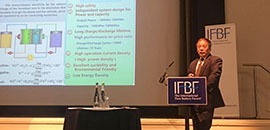 07 01, 2017The 8th International Flow Battery Forum Has Been Held in Manchester, U.K
07 01, 2017The 8th International Flow Battery Forum Has Been Held in Manchester, U.K
The 8th international flow battery forum (IFBF) has been held in Manchester, U.K. from June 27 to 29 in 2017. More than 300 participants all over the world who are from flow battery R&D companies, materials suppliers, energy storage users and academic institutions attended this meeting.
Three keynote talks were presented in this meeting. Prof. Maria Skyllas-Kazacos who is from the University of New South Wales is the founder of vanadium flow battery. He introduced the increased requirement of energy storage capacity in Australia and the R&D of vanadium flow battery technology to date.
Professor ZHANG Huamin from Dalian Institute of Chemical Physics (DICP) of Chinese Academy of Sciences (CAS) is the person who firstly industrialized vanadium flow battery technology. He introduced the recent progress on the fundamental research and industrial applications of flow battery by DICP/Rongke Power. His introductions of the capacity of 300MW/year of Rongke Equipment Company and the 200MW/800MWh vanadium flow battery power station attracted lots of attetions and were highly praised by the attendee.
Professor Michael Aziz from Harvard University introduced the development and challenge of new types of aqueous organic and organic metal flow batteries.
The hot topics in this meeting are market environment, policy, business model and application popularity of energy storage.
This meeting is beneficial for the further understanding and communication of flow battery technology among the flow battery R&D companies, materials suppliers, energy storage users and academic institutions. It can accelerate the development of flow battery technology significantly. (Text and Image by YUE Meng and ZHENG Qiong) -
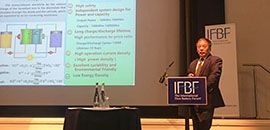 07 01, 2017The 8th International Flow Battery Forum Has Been Held in Manchester, U.K
07 01, 2017The 8th International Flow Battery Forum Has Been Held in Manchester, U.K
The 8th international flow battery forum (IFBF) has been held in Manchester, U.K. from June 27 to 29 in 2017. More than 300 participants all over the world who are from flow battery R&D companies, materials suppliers, energy storage users and academic institutions attended this meeting.
Three keynote talks were presented in this meeting. Prof. Maria Skyllas-Kazacos who is from the University of New South Wales is the founder of vanadium flow battery. He introduced the increased requirement of energy storage capacity in Australia and the R&D of vanadium flow battery technology to date.
Professor ZHANG Huamin from Dalian Institute of Chemical Physics (DICP) of Chinese Academy of Sciences (CAS) is the person who firstly industrialized vanadium flow battery technology. He introduced the recent progress on the fundamental research and industrial applications of flow battery by DICP/Rongke Power. His introductions of the capacity of 300MW/year of Rongke Equipment Company and the 200MW/800MWh vanadium flow battery power station attracted lots of attetions and were highly praised by the attendee.
Professor Michael Aziz from Harvard University introduced the development and challenge of new types of aqueous organic and organic metal flow batteries.
The hot topics in this meeting are market environment, policy, business model and application popularity of energy storage.
This meeting is beneficial for the further understanding and communication of flow battery technology among the flow battery R&D companies, materials suppliers, energy storage users and academic institutions. It can accelerate the development of flow battery technology significantly. (Text and Image by YUE Meng and ZHENG Qiong) -
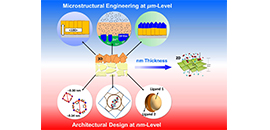 06 29, 2017DICP Scientists Publish Progress Report on MOF Membranes in Advanced MaterialsThe research team led by Prof. YANG Weishen in Dalian Institute of Chemical Physics (DICP) of the Chinese Academy of Sciences(CAS) has attracted wide attention on the study of metal-organic framework (MOF) membranes. And they were invited to publish a “progress report” which is entitled as “Microstructural Engineering and Architectural Design of Metal-Organic Framework Membranes” in Advanced Materials in June, 2017.
06 29, 2017DICP Scientists Publish Progress Report on MOF Membranes in Advanced MaterialsThe research team led by Prof. YANG Weishen in Dalian Institute of Chemical Physics (DICP) of the Chinese Academy of Sciences(CAS) has attracted wide attention on the study of metal-organic framework (MOF) membranes. And they were invited to publish a “progress report” which is entitled as “Microstructural Engineering and Architectural Design of Metal-Organic Framework Membranes” in Advanced Materials in June, 2017.
The research team led by Prof. YANG Weishen in Dalian Institute of Chemical Physics (DICP) of the Chinese Academy of Sciences (CAS) has attracted wide attentions on the study of metal-organic framework (MOF) membranes. And they were invited to publish a “progress report” which is entitled as “Microstructural Engineering and Architectural Design of Metal-Organic Framework Membranes” in Advanced Materials in June, 2017.
MOFs, which are a new class of molecular sieve materials, present the properties of permanent porosity and adjustability in both architecture and functionality.
Separation technology based on pure MOF membranes and mixed-phase MOF composite membranes has been successfully applied in gas separation and liquid refinery. Compared with traditional cryogenic distillation and chemical absorption process, MOFs have a higher efficiency and a lower energy consumption.
However, in order to reach an economically attractive region, it’s necessary to further improve the separation performance of MOF membranes, including permeability and selectivity.
Scientists from the research team led by Prof. YANG Weishen in DICP have been doing lots of work on MOFs and have attracted substantial attentions all over the world. In June, they were invited to publish a review on the topic of MOF membranes.
They reviewed the microstructural engineering of MOF membranes at mesoscopic levels, including orientation manipulation, static/dynamic interfacial synthesis, and mixed-phase reinforce. Moreover, they summarized the architectural design of MOF membranes at microscopic levels such as aperture size adjustment, cage modification and functional group post-decoration. Such modifications can be contributed to improve the performance of MOF membranes.
Last but not the least, they discussed the future opportunities of 2D ultrathin MOF membranes with precise molecular sieving properties and superb permeability.
Microstructural Engineering and Architectural Design of Metal–Organic Framework Membranes (Image by BAN Yujie)
This work is financially supported by the Strategic Priority Research Program of the Chinese Academy of Sciences and the Fundamental Research Funds for the Central Universities. (Text and Image by BAN Yujie)
Dr. WANG Yongjin
Dalian Institute of Chemical Physics, Chinese Academy of Sciences,
457 Zhongshan Road, Dalian, 116023, China,
Tel: 86-411-84374221
E-mail: wangyj@dicp.ac.cn -
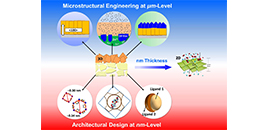 06 29, 2017DICP Scientists Publish Progress Report on MOF Membranes in Advanced MaterialsThe research team led by Prof. YANG Weishen in Dalian Institute of Chemical Physics (DICP) of the Chinese Academy of Sciences(CAS) has attracted wide attention on the study of metal-organic framework (MOF) membranes. And they were invited to publish a “progress report” which is entitled as “Microstructural Engineering and Architectural Design of Metal-Organic Framework Membranes” in Advanced Materials in June, 2017.
06 29, 2017DICP Scientists Publish Progress Report on MOF Membranes in Advanced MaterialsThe research team led by Prof. YANG Weishen in Dalian Institute of Chemical Physics (DICP) of the Chinese Academy of Sciences(CAS) has attracted wide attention on the study of metal-organic framework (MOF) membranes. And they were invited to publish a “progress report” which is entitled as “Microstructural Engineering and Architectural Design of Metal-Organic Framework Membranes” in Advanced Materials in June, 2017.
The research team led by Prof. YANG Weishen in Dalian Institute of Chemical Physics (DICP) of the Chinese Academy of Sciences (CAS) has attracted wide attentions on the study of metal-organic framework (MOF) membranes. And they were invited to publish a “progress report” which is entitled as “Microstructural Engineering and Architectural Design of Metal-Organic Framework Membranes” in Advanced Materials in June, 2017.
MOFs, which are a new class of molecular sieve materials, present the properties of permanent porosity and adjustability in both architecture and functionality.
Separation technology based on pure MOF membranes and mixed-phase MOF composite membranes has been successfully applied in gas separation and liquid refinery. Compared with traditional cryogenic distillation and chemical absorption process, MOFs have a higher efficiency and a lower energy consumption.
However, in order to reach an economically attractive region, it’s necessary to further improve the separation performance of MOF membranes, including permeability and selectivity.
Scientists from the research team led by Prof. YANG Weishen in DICP have been doing lots of work on MOFs and have attracted substantial attentions all over the world. In June, they were invited to publish a review on the topic of MOF membranes.
They reviewed the microstructural engineering of MOF membranes at mesoscopic levels, including orientation manipulation, static/dynamic interfacial synthesis, and mixed-phase reinforce. Moreover, they summarized the architectural design of MOF membranes at microscopic levels such as aperture size adjustment, cage modification and functional group post-decoration. Such modifications can be contributed to improve the performance of MOF membranes.
Last but not the least, they discussed the future opportunities of 2D ultrathin MOF membranes with precise molecular sieving properties and superb permeability.
Microstructural Engineering and Architectural Design of Metal–Organic Framework Membranes (Image by BAN Yujie)
This work is financially supported by the Strategic Priority Research Program of the Chinese Academy of Sciences and the Fundamental Research Funds for the Central Universities. (Text and Image by BAN Yujie)
Dr. WANG Yongjin
Dalian Institute of Chemical Physics, Chinese Academy of Sciences,
457 Zhongshan Road, Dalian, 116023, China,
Tel: 86-411-84374221
E-mail: wangyj@dicp.ac.cn -
 06 27, 2017Closing Meeting: China/UK Cooperation Project on Flow Battery Technology
06 27, 2017Closing Meeting: China/UK Cooperation Project on Flow Battery Technology
The closing meeting of China/United Kingdom(UK) cooperation project of "Lower Cost and Longer Life Flow Batteries for Grid Scale Energy Storage" was held on June 23, 2017 in University College London. This project was financed by National Natural Science Foundation of China and Engineering and Science Research Council of UK.
15 participants who are from Dalian Institute of Chemical Physics (DICP) of Chinese Academy of Sciences (CAS), Imperial College London (ICL) and University College London (UCL) attended the closing meeting. The project leader of China and UK is Prof. ZHANG Huamin of DICP and Prof. Nigel Brandon of ICL, respectively.
During the closing meeting, scientists introuduced the research and development of flow battery technology in China and UK. Members from UK fully affirmed the domestic and international leading position of DICP on flow battery technology, and they highly praise the significant progress of DICP on the fundamental research and industrial application of flow battery technology.
After the meeting, both sides expressed the desire to enhance the further cooperation between China and UK by organizing some international meetings and publishing some high level review papers on flow battery technology cooperately. They are looking forward to promoting the deep communication and cooperation internationally.
The China/UK cooperation project was approved on 2013 with a duration of 3 years. During this period, an academic communication meeting was held every year.(Text and image by ZHENG Qiong)
-
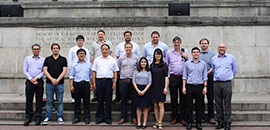 06 27, 2017Closing Meeting: China/UK Cooperation Project on Flow Battery Technology
06 27, 2017Closing Meeting: China/UK Cooperation Project on Flow Battery Technology
The closing meeting of China/United Kingdom(UK) cooperation project of "Lower Cost and Longer Life Flow Batteries for Grid Scale Energy Storage" was held on June 23, 2017 in University College London. This project was financed by National Natural Science Foundation of China and Engineering and Science Research Council of UK.
15 participants who are from Dalian Institute of Chemical Physics (DICP) of Chinese Academy of Sciences (CAS), Imperial College London (ICL) and University College London (UCL) attended the closing meeting. The project leader of China and UK is Prof. ZHANG Huamin of DICP and Prof. Nigel Brandon of ICL, respectively.
During the closing meeting, scientists introuduced the research and development of flow battery technology in China and UK. Members from UK fully affirmed the domestic and international leading position of DICP on flow battery technology, and they highly praise the significant progress of DICP on the fundamental research and industrial application of flow battery technology.
After the meeting, both sides expressed the desire to enhance the further cooperation between China and UK by organizing some international meetings and publishing some high level review papers on flow battery technology cooperately. They are looking forward to promoting the deep communication and cooperation internationally.
The China/UK cooperation project was approved on 2013 with a duration of 3 years. During this period, an academic communication meeting was held every year.(Text and image by ZHENG Qiong)